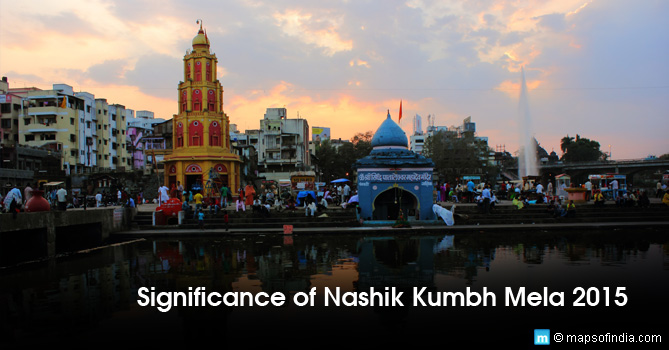The Kumbh Melas of India
Kumbh Melas are much-awaited occasions in India. Hundreds of thousands of pilgrims gather and bathe in a holy river. Four Kumbh Melas are held in India – the Maha Kumbh Mela at Allahabad, and three others at Haridwar, Nashik and Ujjain. Ardha or Half Kumbh Melas are also held every sixth year. They are held only in Haridwar and Allahabad. The highlight of these Kumbh Melas, apart from the crowd, is a dip in the sacred rivers. In Haridwar, the Ganges leaves the mountains and starts to flow across the north Indian plains. The confluence of the Ganges and the Yamuna makes Allahabad sacred. While Godavari graces Nashik, Shipra snakes her way through Ujjain. A dip in these rivers during the Kumbh Mela is said to cleanse devotees of their sins and aid their spiritual journey.
Nashik Kumbh Mela 2015
In a grand ceremony marked by hymn-chanting and religious fervour, the Nashik-Trimbakeshwar Simhastha Kumbh Mela commenced on 14 July. The Chief Minister of Maharashtra, Devendra Fadnavis, and Union Home Minister Rajnath Singh hoisted the ceremonial flags in Nashik and Trimbakeshwar respectively. The main ceremonies, hoisting of flags at Ram Kund (Nashik) and Kushavarta Teertha (Triambakeshwar) were organised by the Nashik Ganga Godavari Panchkothi Purohit Sangh and Trimbakeshwar Purohit Sangh respectively. Thousands of monks and ordinary people alike thronged the two sacred places celebrating the coming together of the Sun and Jupiter in Leo zodiac sign.
The “Sadhu Gram” that has been set up over an area of 315 acres in Nashik is meant to house the Hindu monks arriving in the city. Tents, makeshift toilets, kitchenettes have been set up and arrangements for drinking water have been made. On the special ‘Parvani’ days about 80 lakh people are expected to visit Nashik and an additional 30 lakh will head to Triambakeshwar. About 15,000 policemen will be deployed on these days to manage the crowd. The Maharashtra State Road Transport Corporation will run over 3000 special buses to and from Nashik on these days.
Significance of Nashik
The Kumbha Mela of Nashik is held every 12 years on the banks of River Godavari. Godavari is India’s second longest river originating near Nashik and traversing over 1400 km of the Deccan area before emptying into the Bay of Bengal in Andhra Pradesh. According to the Ramayana, the banks of the Godavari at Nashik are considered very sacred as Lord Rama had come to stay here. Triambakeshwar is at a distance of about 29 km from Nashik and the Shiva temple here enshrines one of the 12 Jyotirlingas of India.
Triambakeshwar and Ramkund
Through the early 1700s, there was much dispute over the Vaishnavas (Vishnu worshippers) and Shaivas (Shiva worshippers) over the right to take the first holy dip in the Godavari during the Kumbh Mela. Peshwa Sadashivrao, the ruler, in an effort to bring peace to the two communities ruled that Vaishnavas would take part in the Shahi Snan (holy dip) at Ramkund in Nashik while all Shaivas would take theor Shahi Snan at the Kushavarta Teertha at Trambakeshwar. This tradition is still followed. Out of the 6 parvani (special) days, three are meant for a holy bath in Ramkund and three in Kushavarta Teertha (Triambakeshwar).
Legend Has It…
The origins of the Kumbha Mela at Nashik are not known. According to Hindu mythology, the demigods (Devas) lost all their powers having incurred the wrath and curse of Sage Durvasa. To regain their strength, the Devas started to churn the Ksheera Sagara (ocean of milk) as instructed by Lord Vishnu. Unable to undertake the task alone, the Devas enlisted the help of traditional rivals, the Asuras (demons). Out of the ocean, emerged a pot (Kumbh) with the nectar of immortality (Amrita). In the tussle between the Devas and Asuras to secure the nectar, a few drops fell and landed in the four holy places where the Kumbh Melas are now held. Sun and the Jupiter were believed to be in the Leo constellation when this nectar fell from the heavens. This is when the practice of bathing in the Godavari at the start of Jupiter’s Leo transit started.
Nashik Kumbh Mela Calendar
In 2015, the Nashik Kumbha Mela will be held between 14 July, 2015 (Tuesday) and 25 September, 2015 (Friday). The Sinhastha Fair (Mela) is formally declared open on Aashad Krushan Trayodashi, Tuesday, 14 July, 2015, on Shaka year 1937, at 6.26 am.
Following is the schedule of events to be followed:
| Date | Day | Event |
| 14 July, 2015 | Tuesday | Mela inauguration, hoisting of flag and main ceremony at Ramkund |
| 19 August, 2015 | Friday | Hoisting of flag (Akhara) at Sadhugram |
| 15 August, 2015 | Saturday | 1st day of Shravan (Amavasyant Lunar Calendar) |
| 26 August, 2015 | Wednesday | Shravan Shudha – First Holy Dip |
| 29 August, 2015 | Saturday | Shravan Shudha Purnima – First Shahi Snan/Holy |
| 13 September, 2015 | Sunday | Bhadrapad Shravan Krushana – Second Shahi Snan/Holy Dip |
| 25 September, 2015 | Friday | Bhadrapad Shukla Dwadashi – Third Shahi Snan/Holy Dip |
Apart from these dates, a dip in the Godavari on all the Mondays of the Shravan month (15 August 2015 to 14 September 2015 as per the Amavasyant Calender) is considered very auspicious.
Astrological Implications of Jupiter’s Transit
According to Indian astrologers, Jupiter is the planet of knowledge, generosity, spirituality, and stateliness. Jupiter is also referred to as the Lord of Fortune and represents the Guru or teacher. On 14 July 2015, Jupiter is leaving his position of exhalation in Cancer and entering the zodiac of Leo (Simha) where it is likely to stay for about a year. While the effect of this transit on individual shall vary, Indian astrologers seem quite unanimous on its effects on Indian society and politics. The year to come shall be one of great advancement and progress for the nation. Education, culture, and India’s status in the global community are likely to receive a boost, say astrologers from across the country.
Read More
Godavari Maha Pushkaram of Andhra Pradesh and Telangana
Information about Maha Kumbh Mela
Maha Kumbh Mela 2013: It is all digital now
Ardh Kumbh in Haridwar
Kumbh Mela in Haridwar
Where is Nashik
Places to Visit in Nashik
Nashik City Map
Nashik Road Map




